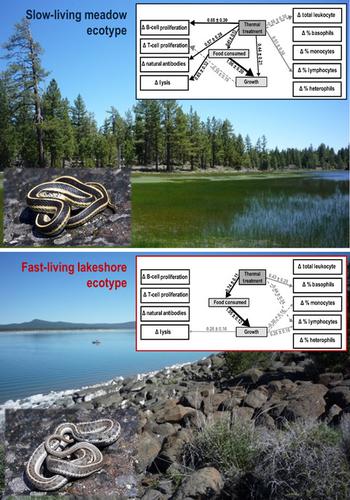当前位置:
X-MOL 学术
›
J. Anim. Ecol.
›
论文详情
Our official English website, www.x-mol.net, welcomes your
feedback! (Note: you will need to create a separate account there.)
Genetic background and thermal environment differentially influence the ontogeny of immune components during early life in an ectothermic vertebrate
Journal of Animal Ecology ( IF 3.5 ) Pub Date : 2020-07-12 , DOI: 10.1111/1365-2656.13271 Maria G Palacios 1 , Eric J Gangloff 1 , Dawn M Reding 1 , Anne M Bronikowski 1
Journal of Animal Ecology ( IF 3.5 ) Pub Date : 2020-07-12 , DOI: 10.1111/1365-2656.13271 Maria G Palacios 1 , Eric J Gangloff 1 , Dawn M Reding 1 , Anne M Bronikowski 1
Affiliation

|
1.An understudied aspect of vertebrate ecoimmunology has been the relative contributions of environmental factors (E), genetic background (G), and their interaction (G × E) in shaping immune development and function. Environmental temperature is known to affect many aspects of immune function and alterations in temperature regimes have been implicated in emergent disease outbreaks, making it a critical environmental factor to study in the context of immune phenotype determinants of wild animals. 2.We assessed the relative influences of environmental temperature, genetic background, and their interaction on first-year development of innate and adaptive immune defenses of captive-born garter snakes (Thamnophis elegans) using a reciprocal-transplant laboratory experiment. We used a full-factorial design with snakes from two divergent life-history ecotypes, which are known to differ in immune function in their native habitats, raised under conditions mimicking the natural thermal regime -i.e., warmer and cooler- of each habitat. 3.Genetic background (ecotype) and thermal regime influenced innate and adaptive immune parameters of snakes, but in an immune-component specific manner. We found some evidence of G × E interactions but no indication of adaptive plasticity with respect to thermal environment. At the individual level, the effects of thermal environment on resource allocation decisions varied between the fast- and the slow-paced life-history ecotypes. Under warmer conditions, which increased food consumption of individuals in both ecotypes, the former invested mostly in growth, whereas the latter invested more evenly between growth and immune development. 4.Overall, immune parameters were highly flexible, but results suggest that other environmental factors are likely more important than temperature per se in driving the ecotype differences in immunity previously documented in the snakes under field conditions. Our results also add to the understanding of investment in immune development and growth during early postnatal life under different thermal environments. Our finding of immune-component specific patterns strongly cautions against oversimplification of the highly complex immune system in ecoimmunological studies. In conjunction, these results deepen our understanding of the degree of immunological flexibility wild animals present, information that is ever more vital in the context of rapid global environmental change.
中文翻译:

遗传背景和热环境对变温脊椎动物早期免疫成分的个体发育有不同的影响
1.脊椎动物生态免疫学的一个未充分研究的方面是环境因素 (E)、遗传背景 (G) 及其相互作用 (G × E) 在塑造免疫发育和功能方面的相对贡献。众所周知,环境温度会影响免疫功能的许多方面,温度状态的改变与突发疾病的爆发有关,这使其成为在野生动物免疫表型决定因素背景下研究的关键环境因素。2.我们使用相互移植实验室实验评估了环境温度、遗传背景及其相互作用对圈养出生的吊袜带蛇(Thamnophis elegans)的先天性和适应性免疫防御第一年发育的相对影响。我们对来自两种不同生活史生态型的蛇使用了全因子设计,已知它们在其原生栖息地的免疫功能不同,在模仿自然热状态的条件下饲养 - 即,较暖和较冷的每个栖息地。3.遗传背景(生态型)和热状态影响蛇的先天和适应性免疫参数,但以免疫成分特异性方式。我们发现了 G × E 相互作用的一些证据,但没有迹象表明对热环境具有适应性可塑性。在个体层面,热环境对资源分配决策的影响在快节奏和慢节奏的生活史生态类型之间有所不同。在温暖的条件下,这两种生态型个体的食物消费增加,前者主要投资于增长,而后者在生长和免疫发育之间的投资更加均衡。4.总的来说,免疫参数是高度灵活的,但结果表明,其他环境因素可能比温度本身更重要,在驱动先前记录的野外条件下蛇的免疫生态型差异方面。我们的结果还增加了对不同热环境下出生后早期免疫发育和生长投资的理解。我们对免疫成分特异性模式的发现强烈警告不要在生态免疫学研究中过度简化高度复杂的免疫系统。总之,这些结果加深了我们对野生动物存在的免疫灵活性程度的理解,
更新日期:2020-07-12
中文翻译:

遗传背景和热环境对变温脊椎动物早期免疫成分的个体发育有不同的影响
1.脊椎动物生态免疫学的一个未充分研究的方面是环境因素 (E)、遗传背景 (G) 及其相互作用 (G × E) 在塑造免疫发育和功能方面的相对贡献。众所周知,环境温度会影响免疫功能的许多方面,温度状态的改变与突发疾病的爆发有关,这使其成为在野生动物免疫表型决定因素背景下研究的关键环境因素。2.我们使用相互移植实验室实验评估了环境温度、遗传背景及其相互作用对圈养出生的吊袜带蛇(Thamnophis elegans)的先天性和适应性免疫防御第一年发育的相对影响。我们对来自两种不同生活史生态型的蛇使用了全因子设计,已知它们在其原生栖息地的免疫功能不同,在模仿自然热状态的条件下饲养 - 即,较暖和较冷的每个栖息地。3.遗传背景(生态型)和热状态影响蛇的先天和适应性免疫参数,但以免疫成分特异性方式。我们发现了 G × E 相互作用的一些证据,但没有迹象表明对热环境具有适应性可塑性。在个体层面,热环境对资源分配决策的影响在快节奏和慢节奏的生活史生态类型之间有所不同。在温暖的条件下,这两种生态型个体的食物消费增加,前者主要投资于增长,而后者在生长和免疫发育之间的投资更加均衡。4.总的来说,免疫参数是高度灵活的,但结果表明,其他环境因素可能比温度本身更重要,在驱动先前记录的野外条件下蛇的免疫生态型差异方面。我们的结果还增加了对不同热环境下出生后早期免疫发育和生长投资的理解。我们对免疫成分特异性模式的发现强烈警告不要在生态免疫学研究中过度简化高度复杂的免疫系统。总之,这些结果加深了我们对野生动物存在的免疫灵活性程度的理解,









































 京公网安备 11010802027423号
京公网安备 11010802027423号